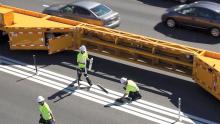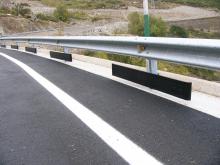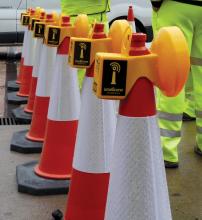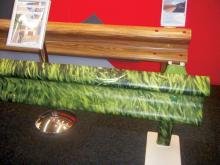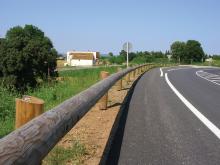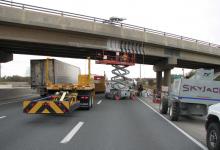Cutting-edge barriers offering greater safety at the same time as limiting traffic disruption are proving in demand on busy world highways, as Guy Woodford reports
Small footprint; minimum disruption after impact; lower labour costs; all said to be elements contributing to the growing popularity of the Trend terminal from Trinity Highway Products.
This family of end terminals offers a range of safe and efficient solutions to barrier ends with quick and easy assembly and installation. Trinity claims th
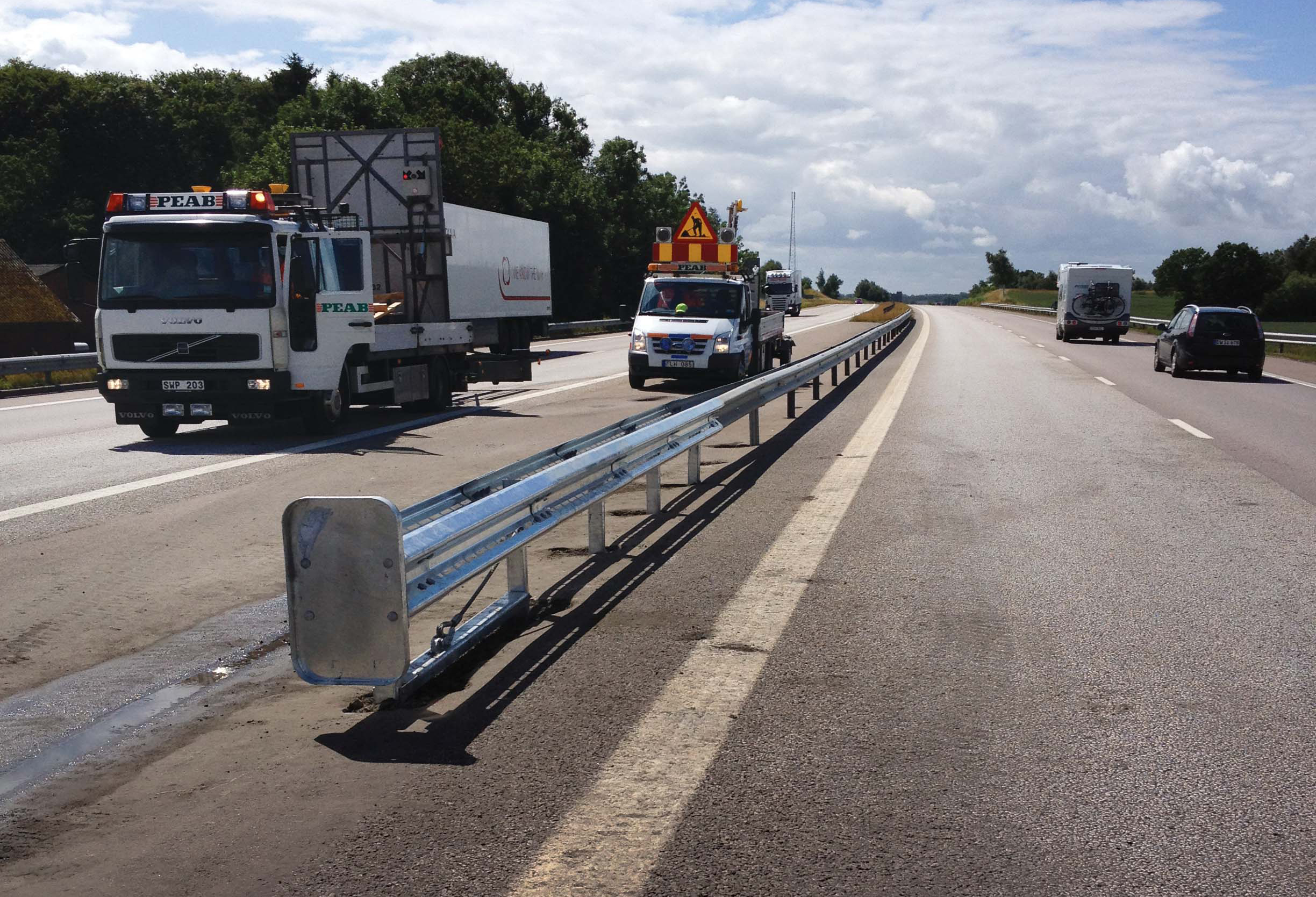
A Trend terminal by Trinity Highway Products on the E4 Örkelljunga highway in Skåne, Sweden
Cutting-edge barriers offering greater safety at the same time as limiting traffic disruption are proving in demand on busy 3260 World Highways, as Guy Woodford reports
Small footprint; minimum disruption after impact; lower labour costs; all said to be elements contributing to the growing popularity of the Trend terminal from7402 Trinity Highway Products.
This family of end terminals offers a range of safe and efficient solutions to barrier ends with quick and easy assembly and installation. Trinity claims that according to recent feedback from a US-based installation crew, the Trend Median system can be installed in just 30 minutes using two workers and has a minimal repair procedure requiring one hour or less.
This energy-absorbing terminal is designed for use with W-Beam barrier and uses breakaway steel posts and a combination of friction and metal deformation to absorb the energy of the impacting vehicle.
One of the main features of the Trend is the very small amount of lateral debris it leaves after impact (less than a metre after a design impact at 110km/h) making it a good option for locations with restricted space.
The Trend terminal range includes single-sided roadside or verge systems as well as double-sided or median systems for use in the centre of the highway.
Another plus point of the Trend is its relatively small footprint. For example, the double-sided Trend CEN DS terminal for 110km/h locations is a 5-post system at only 8.4m long and for 80km/h locations it is a three-post system at only 4.4m long.
The Trend family has undergone comprehensive testing and meets all requirements internationally, with systems tested to both NCHRP 350 as well as ENV1317-4 for performance levels up to 110km/h.
Mobile Barriers multiple-award winning MBT-1 mobile barrier was recently used in the972 US State of California to help complete a full road cut and culvert replacement in two nights, without closing the road, on the heavily travelled 101 Interstate between San Francisco and Los Angeles.
Granite Construction brought the barrier out on both nights just after dark to close and protect first the left and then the right half of the road as a 2m deep trench was dug across the lanes and new culvert installed. Each night the MBT-1 mobile barrier was pulled in place and crews immediately went to work. Traffic continued to pass at speed throughout the night and the road was fully reopened each morning. A spokesperson for Interstate Barriers (IB), who provided the MBT-1 said, “It went very smoothly. There was no on-site setup, everyone was ready to go and the work went very well. Granite did a great job. Traffic continued to flow with minimal interruption. Everyone stayed safe.”
The recent California job was similar to the full road cut that MBT-1 was used on in Colorado a couple of years ago. In that case, the Colorado Department of Transportation had to do a multi-lane cut to repair a bridge approach. “They completed the job in one night,” said Kevin Groeneweg, CEO of6724 Mobile Barriers. “They pulled in after dark and were off the road again before morning. The job had been expected to take several days, and the impact on traffic was a serious concern. It was a high volume area but they finished the first night. The road was open and clear the rest of the week. It worked out great for everyone.”
Last year in Oregon, MBT-1 was similarly used to protect an 8x4x.6m lane cut (length/width/depth). On that project, the barrier was hit by and had to turn and redirect two semi-trucks. “If either truck had gotten into the work area, it would have been bad for all concerned and would probably have closed the road,” said John Stockman of Barriers Northwest, who was called in on the incidents. The MBT-1 barrier held its ground and sustained only minor damage and some scratched paint.
“Improving safety, efficiency and traffic flows is more than a mantra” said Groeneweg. “The barrier was designed to help better protect workers, but it is as much about reducing impacts on the travelling public, keeping traffic flowing and getting out of the way. The better we do at the latter, the better we do for the former.”
The I-794 freeway and Hoan Bridge are key links in the US state of Wisconsin’s south-eastern transport network, connecting to I-94 and I-43 in downtown Milwaukee. As part of a US$278 million project that will replace the entire bridge deck, among other improvements, moveable median barriers have been installed on the bridge to allow for two open lanes heading north for morning commuters and two southbound lanes as workers drive home in the evening.
In order to increase traffic control safety, provide a safe environment for workers and motorists, and to take advantage of innovations to bring costs down,3473 Walsh Construction and the Wisconsin DOT chose a novel approach for their daily lane closures in each diection. Automated warning signs (SwiftSign) and automated gates (SwiftGate) from Canadian firm 2303 Versilis have been installed at both ends of the moveable barrier. All signs and gates are deployed and retracted using a single remote control, making for a safe and fast operation. Flashing LED lighting on the gates is said to improve visibility of the lane closures, providing a better warning for drivers especially during the dark winter months.
Winter operations are nothing new for Versilis, who have been field-testing their products for many years in the most adverse environmental conditions. In the coming years, Versilis say road users will see more and more of their automated warning gates as they are being integrated in permanent projects for HOV slip ramp control, on-ramp and off-ramp control, median access control and various other applications.
Tertu says the demand for environment- friendly crashworthy and aesthetic safety devices has constantly increased worldwide for the last two decades, creating fierce competition.
The France-based road safety barrier specialist has been extremely active internationally in close cooperation with a carefully selected exclusive team of distributors, covering more than 25 countries in Europe and various partnerships or license agreements in other countries such as Chile, New Zealand and South Korea. In 2011, the company founded a Shanghai-based subsidiary for developing its activities in China.
In order to develop its market shares, Tertu dedicates significant resources to research and development. Recently, the firm successfully crash tested at containment level N2 (1.5tonne car at 110km/h) its TM 18 barrier in two configurations: with a 4m post spacing and working width W5 (1.7m), said in this way to offer a significantly attractive low-cost solution; and with a 2m post spacing, with a W4 (1.3m) working width.
Tertu claims to offer the widest range of steel-backed timber crash barriers on the market, including 8 CE marked N2 or H2 systems with working widths from W3 to W7, according to EN 1317, and a TL 3 NCHRP 350 approved guardrail. The firm says all its devices are highly reliable and easy to install.
Around 10,000kms of Safence wire rope safety fence from Swedish cable barrier developer Blue Systems has now been installed on many highways across Europe, Africa, North, Central and South America, the Middle East, and Australasia.
Available as a side, slope or median barrier, Safence is designed to meet the requirements for road safety barriers according to NCHRP 350 and the European EN 1317 standards.
For many, highway cable barrier safety solutions like this illustrate how Sweden has for decades been among the leading nations for traffic safety progress.
“In 1997 the Swedish parliament introduced the Vision Zero initiative, setting up a strong goal of zero fatalities and serious injuries by the year 2020. While being something of a utopian idea with the technology we have at hand today, every action taken to prevent another addition to the statistical column for fatalities or serious injuries is a win,” said Blue Systems’ Rickard Svensson.
From 1992 to 2012, notes Svensson, Sweden´s number of traffic related fatalities dropped from 759 to 286. “One of the biggest parts in Sweden’s success is seen through its improvement of roadside design to forgive human errors,” he added.
Road safety barriers are used to part oncoming traffic as well as protect road users from unyielding objects in road periphery, such as trees, rock, water hazards or manmade elements including lighting posts and bridge structures.
“Cable barriers have demonstrated impressive ability to generate great road user protection for a comparative low cost,” continued Svensson. “The sustainable idea is simple: get as much road safety as possible from every investment. As well as using a minimal amount of material, cable barrier installations result in longer distances of barrier protection; potentially saving more lives.”
Svensson said that Sweden started installing cable barriers on its national roads’ network in the early 1990s. In 1998 the Swedish Road Administration revolutionised the field of road safety work by introducing the 2+1 lane road with median barrier to separate oncoming traffic. The 2+1 lane road was made possible, said Svensson, by the “simple” technology of cable barriers: a sleek and narrow road barrier capable of catching all road-using vehicles.
He added, “The 2+1 lane road model has since been adopted by countries including Austria, Norway, Australia, New Zealand, Ireland, Iceland and South Africa. In Sweden alone, the median cable barrier 2+1 lane road is said to save well over 60 lives every single year.
“Every year Swedish transport authorities continue to extend their coverage of cable barriers on the main road network, while more and more other nations embrace cable barriers technology, creating a forgiving road environment.”
Small footprint; minimum disruption after impact; lower labour costs; all said to be elements contributing to the growing popularity of the Trend terminal from
This family of end terminals offers a range of safe and efficient solutions to barrier ends with quick and easy assembly and installation. Trinity claims that according to recent feedback from a US-based installation crew, the Trend Median system can be installed in just 30 minutes using two workers and has a minimal repair procedure requiring one hour or less.
This energy-absorbing terminal is designed for use with W-Beam barrier and uses breakaway steel posts and a combination of friction and metal deformation to absorb the energy of the impacting vehicle.
One of the main features of the Trend is the very small amount of lateral debris it leaves after impact (less than a metre after a design impact at 110km/h) making it a good option for locations with restricted space.
The Trend terminal range includes single-sided roadside or verge systems as well as double-sided or median systems for use in the centre of the highway.
Another plus point of the Trend is its relatively small footprint. For example, the double-sided Trend CEN DS terminal for 110km/h locations is a 5-post system at only 8.4m long and for 80km/h locations it is a three-post system at only 4.4m long.
The Trend family has undergone comprehensive testing and meets all requirements internationally, with systems tested to both NCHRP 350 as well as ENV1317-4 for performance levels up to 110km/h.
Mobile Barriers multiple-award winning MBT-1 mobile barrier was recently used in the
Granite Construction brought the barrier out on both nights just after dark to close and protect first the left and then the right half of the road as a 2m deep trench was dug across the lanes and new culvert installed. Each night the MBT-1 mobile barrier was pulled in place and crews immediately went to work. Traffic continued to pass at speed throughout the night and the road was fully reopened each morning. A spokesperson for Interstate Barriers (IB), who provided the MBT-1 said, “It went very smoothly. There was no on-site setup, everyone was ready to go and the work went very well. Granite did a great job. Traffic continued to flow with minimal interruption. Everyone stayed safe.”
The recent California job was similar to the full road cut that MBT-1 was used on in Colorado a couple of years ago. In that case, the Colorado Department of Transportation had to do a multi-lane cut to repair a bridge approach. “They completed the job in one night,” said Kevin Groeneweg, CEO of
Last year in Oregon, MBT-1 was similarly used to protect an 8x4x.6m lane cut (length/width/depth). On that project, the barrier was hit by and had to turn and redirect two semi-trucks. “If either truck had gotten into the work area, it would have been bad for all concerned and would probably have closed the road,” said John Stockman of Barriers Northwest, who was called in on the incidents. The MBT-1 barrier held its ground and sustained only minor damage and some scratched paint.
“Improving safety, efficiency and traffic flows is more than a mantra” said Groeneweg. “The barrier was designed to help better protect workers, but it is as much about reducing impacts on the travelling public, keeping traffic flowing and getting out of the way. The better we do at the latter, the better we do for the former.”
The I-794 freeway and Hoan Bridge are key links in the US state of Wisconsin’s south-eastern transport network, connecting to I-94 and I-43 in downtown Milwaukee. As part of a US$278 million project that will replace the entire bridge deck, among other improvements, moveable median barriers have been installed on the bridge to allow for two open lanes heading north for morning commuters and two southbound lanes as workers drive home in the evening.
In order to increase traffic control safety, provide a safe environment for workers and motorists, and to take advantage of innovations to bring costs down,
Winter operations are nothing new for Versilis, who have been field-testing their products for many years in the most adverse environmental conditions. In the coming years, Versilis say road users will see more and more of their automated warning gates as they are being integrated in permanent projects for HOV slip ramp control, on-ramp and off-ramp control, median access control and various other applications.
Tertu says the demand for environment- friendly crashworthy and aesthetic safety devices has constantly increased worldwide for the last two decades, creating fierce competition.
The France-based road safety barrier specialist has been extremely active internationally in close cooperation with a carefully selected exclusive team of distributors, covering more than 25 countries in Europe and various partnerships or license agreements in other countries such as Chile, New Zealand and South Korea. In 2011, the company founded a Shanghai-based subsidiary for developing its activities in China.
In order to develop its market shares, Tertu dedicates significant resources to research and development. Recently, the firm successfully crash tested at containment level N2 (1.5tonne car at 110km/h) its TM 18 barrier in two configurations: with a 4m post spacing and working width W5 (1.7m), said in this way to offer a significantly attractive low-cost solution; and with a 2m post spacing, with a W4 (1.3m) working width.
Tertu claims to offer the widest range of steel-backed timber crash barriers on the market, including 8 CE marked N2 or H2 systems with working widths from W3 to W7, according to EN 1317, and a TL 3 NCHRP 350 approved guardrail. The firm says all its devices are highly reliable and easy to install.
Around 10,000kms of Safence wire rope safety fence from Swedish cable barrier developer Blue Systems has now been installed on many highways across Europe, Africa, North, Central and South America, the Middle East, and Australasia.
Available as a side, slope or median barrier, Safence is designed to meet the requirements for road safety barriers according to NCHRP 350 and the European EN 1317 standards.
For many, highway cable barrier safety solutions like this illustrate how Sweden has for decades been among the leading nations for traffic safety progress.
“In 1997 the Swedish parliament introduced the Vision Zero initiative, setting up a strong goal of zero fatalities and serious injuries by the year 2020. While being something of a utopian idea with the technology we have at hand today, every action taken to prevent another addition to the statistical column for fatalities or serious injuries is a win,” said Blue Systems’ Rickard Svensson.
From 1992 to 2012, notes Svensson, Sweden´s number of traffic related fatalities dropped from 759 to 286. “One of the biggest parts in Sweden’s success is seen through its improvement of roadside design to forgive human errors,” he added.
Road safety barriers are used to part oncoming traffic as well as protect road users from unyielding objects in road periphery, such as trees, rock, water hazards or manmade elements including lighting posts and bridge structures.
“Cable barriers have demonstrated impressive ability to generate great road user protection for a comparative low cost,” continued Svensson. “The sustainable idea is simple: get as much road safety as possible from every investment. As well as using a minimal amount of material, cable barrier installations result in longer distances of barrier protection; potentially saving more lives.”
Svensson said that Sweden started installing cable barriers on its national roads’ network in the early 1990s. In 1998 the Swedish Road Administration revolutionised the field of road safety work by introducing the 2+1 lane road with median barrier to separate oncoming traffic. The 2+1 lane road was made possible, said Svensson, by the “simple” technology of cable barriers: a sleek and narrow road barrier capable of catching all road-using vehicles.
He added, “The 2+1 lane road model has since been adopted by countries including Austria, Norway, Australia, New Zealand, Ireland, Iceland and South Africa. In Sweden alone, the median cable barrier 2+1 lane road is said to save well over 60 lives every single year.
“Every year Swedish transport authorities continue to extend their coverage of cable barriers on the main road network, while more and more other nations embrace cable barriers technology, creating a forgiving road environment.”

